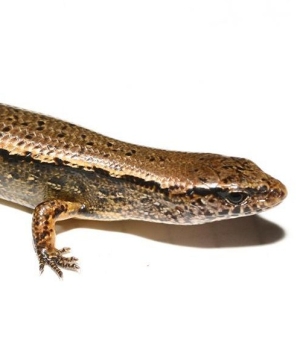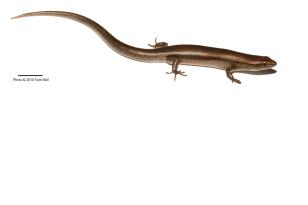If you see a sleek little brown skink slinking around your garden, and you live in the North Island, chances are it’s a copper skink. These guys are more scientifically known as Oligosoma aeneum, and are the second smallest native lizard in New Zealand, not longer than a truly titchy 12 centimetres. While they are active during the day, they are quite cryptic and not often seen until their cover is disturbed. A big fan of moist and humid retreats, gardeners often report finding copper skinks hanging around their compost bins (probably also due to the abundance of insect prey and discarded fruit… a copper skink’s version of The Ritz!). Like all New Zealand lizards (except for Suter’s skink, which is a bit of an egg-laying oddity amongst the Oligosoma), copper skinks give birth to live young. After a pregnancy of three to four months, they produce 4-6 young in mid-summer. It is thought that copper skinks were once found all over the North Island of New Zealand but nowadays like so many of our lizards, their distribution has become fragmented due to habitat loss and predation by introduced animals. While they are the most common native skink seen nowadays in the lowlands of the Waikato, Bay of Plenty, Auckland, Taranaki and Northland regions, they are much more sparse around the Hawke’s Bay, Wellington and Manawatu-Whanganui regions. If you’d like to help, you could create a lizard-friendly spot in your garden – have a look at the DOC online guide to gardening for lizards for some ideas:

In northern parts of the North Island (north of, and including, the Waikato region), copper skinks are easily confused with another very titchy skink, the introduced Australian rainbow skink (Lampropholis delicata). However, copper skinks can be distinguished by their stumpy toes, robust oblong-shaped body, a tail roughly the same length as their body, tooth-like black markings around their ‘lips’ and a brown back, often with a bright copper stripe down each side. In contrast, rainbow skinks are smaller and very slender, have a long, whip-like tail, a very long fourth hind toe, often have an oily-like ‘rainbow’ sheen on their brown backs, and lay white leathery eggs about 1cm long. If you get a very close look (although I don’t recommend picking up copper skinks because they quickly become hot and stressed, and can pass out), you’ll also notice that, like all native skinks, the copper skink has two “frontoparietal” scales on the top of their head whereas the rainbow skink has only one. If you think you’ve seen a rainbow skink or their eggs, and you live south of Waikato, tell someone from DOC immediately, as they are an invasive species that hasn’t yet established in the more southern North Island regions or the South Island. It’s not certain what effect rainbow skinks have on native lizards, but they are very fast breeders that probably compete with native skinks for food and refuges.

Want more information?
New Zealand Lizards database: http://nzlizards.landcareresearch.co.nz
New Zealand Herpetological Society: http://www.reptiles.org.nz/
Photographs kindly provided by Trent Bell.